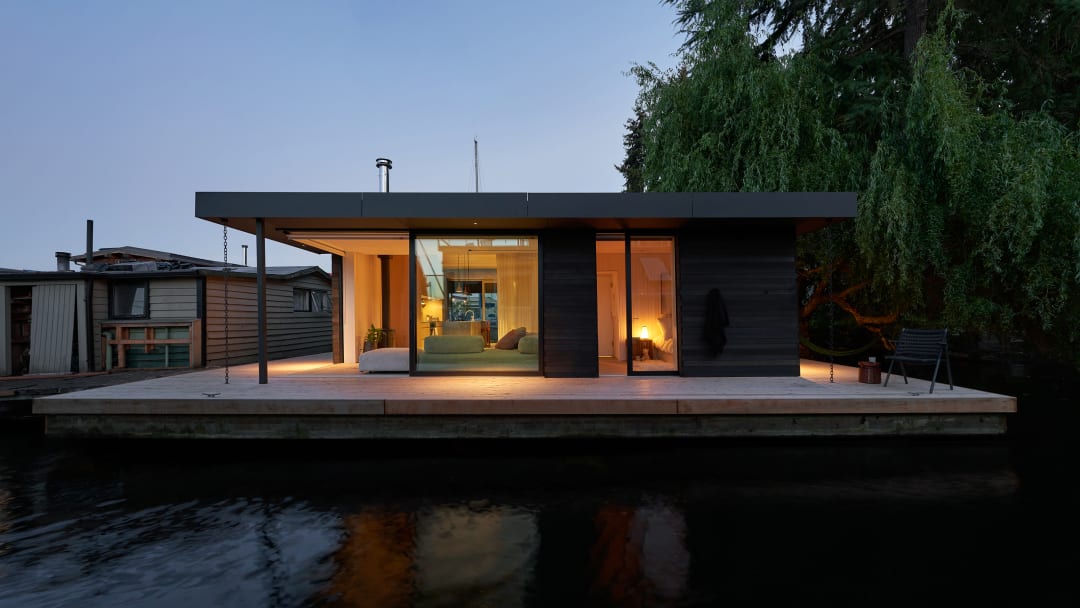2021 Housing Award
Recognizing the best in housing design

A west facing eave provides an extension to living and shelter along the exterior.
The 2021 Housing Awards, presented by the AIA Housing and Community Development Knowledge Community, emphasize the importance of good housing as a necessity of life, a sanctuary for the human spirit, and a valuable national resource. This year, 10 projects were recognized for this honor across four categories:
- Category One: One- and Two-Family Custom Residences
- Category Two: One- and Two-Family Production Homes
- Category Three: Multifamily Housing
- Category Four: Specialized Housing
Adohi Hall
Drawing inspiration from the Cherokee phrase adohi, which translates to woods or timber, this new residence hall at the University of Arkansas is the first large-scale mass timber building in the nation.
Bastion Community
Inspired by the ideals of a community model that places foster children and older caregivers in mutually beneficial living arrangements, Bastion Community promotes an inclusive and thriving live-work environment for returning veterans with lifelong rehabilitation needs and their families. The community’s progressive and supportive living environments reveal the potential of intergenerational communities to address the gap in public and private veteran housing programs.
Edwin M. Lee Apartments
Name in honor of the late Edwin M. Lee, the 43rd mayor of San Francisco who adopted the Mayors Challenge to End Veteran Homelessness, this project provides homes for low-income families and veterans in the city's Mission Bay neighborhood. In a city where affordable housing and access to shared community space is exceedingly rare, Edwin M. Lee Apartments boasts nearly 120 units and ground-floor services for residents and the greater community.
Independence Library and Apartments
Representing an emerging hybrid building typology, this project couples a 16,000-square-foot library with 44 units of affordable apartments for seniors above. The project sits in Chicago's diverse, mixed-income Irving Park neighborhood, which had been without a library since 2015 after a fire shuttered the previous Independence Branch.
LeanToo
When the owners of this project sought to return to the simple, curated life afforded in Austin, Texas, they found a lovely but small 900-square-foot cottage constructed in 1936 to call home. The original home was crowded by a stand of aged and leaning live oaks and faced limited development possibilities because of an underground utility easement. But the team's approach, centered on an understanding of the landscape, delivered a 1,000-square-foot addition that blurs the line between indoor and outdoor spaces.
Loom House
Sitting on a landscaped bluff overlooking Puget Sound, this renovation of a classic mid-century home and standalone office is a model for home renovation using resilient retrofitting strategies. Through net positive energy and water, food production, and adherence to a strict materials list, Loom House is on target to become the first residential remodel certified as a living building by the International Living Future Institute.
Portage Bay Float Home
While the Seattle area has enjoyed a long history of floating homes and houseboats, a type of living romanticized in movies and television, the reality of building on the water is much less glamorous. For this 650-square-foot home on the north end of the city's Lake Union, the owners embraced the challenge because such a home meshed with their aquatic hobbies of sailing, boat building, and scuba diving.
The Arroyo Affordable Housing
Emerging from Santa Monica’s progressive and inclusionary affordable housing policy, the Arroyo affordable housing development boasts 64 units at the edge of the transit-serviced and employment-rich city. Qualifying households in the LEED Platinum complex earn between 30 and 60% of the county-average median income, and many residents work in Santa Monica’s service industry.
Tsuga Townhomes
Seattle’s continually escalating construction costs, among the highest globally and averaging more than $338 per square foot just two years ago, has prompted a glut of high-volume, low-quality housing. The rising costs have transformed many of the city’s neighborhoods into a sea of generic modern boxes, built using low-cost materials and left disconnected from the outdoors. This project helps resolve the paradox around low-cost and high-quality homes while delivering sustainable design.
Walk-Street House
Located just two blocks from the Pacific Ocean in Hermosa Beach, this home for a dynamic young family captures the essence of coastal living in Southern California. The site is distinguished by its situation on a walk-street, a pedestrian-only path in front of the home that is typical of the South Santa Monica Bay region.
Image credits

Kevin Scott
